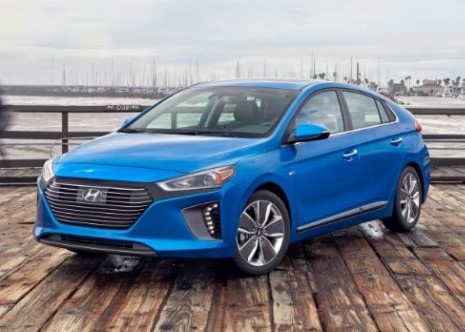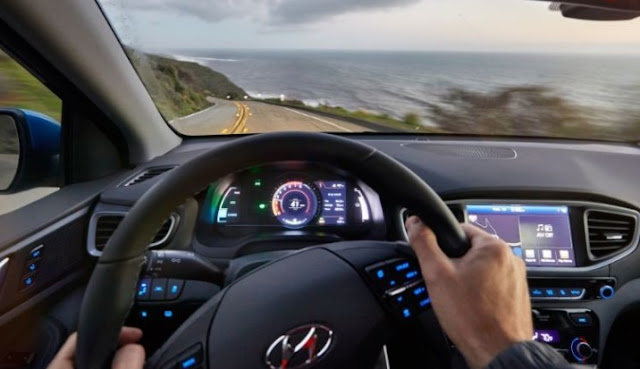 |
| 2017 Hyundai Ioniq Hybrid |
2017 Hyundai Ioniq Hybrid.Hyundai doesn't exactly want to be Toyota, it wants to break Toyota, in part by relentlessly imitating the Big T's jiujitsu. Toyota formed the mass-market composite, and it's pretty much had the corner on it, as others chipped futilely at Fortress Prius with unworthy contestants, including the failed Honda Insight, or balk away from composites altogether.
Yet, even as soft fuel tolls have partly depressed the eco-car business during the past year, Hyundai sees opportunity, both in newfangled ride-sharing sails where the break-even place on a hybrid is easily contacted, and in up-and-coming millennials. They will represent 40 percentage of new-car buy-ers by 2020. And as long as these young'uns remain such courses with their ethics as they senility( just like the baby boomers, cough ), including a liking for city living and smaller electrified vehicles, a ceremony of bearded and plaid-wearing customers could rally right into Hyundai's open arms.
Read Also : 2017 BMW i3 94 ah w/range Extender Release Date
The Ioniq and its sister, the Kia Niro crossover, are precisely volleys one and two in a seven-vehicle broadside over the next year intended to bust the Prius's lock on the average person's mental image of a composite. Hyundai's plan is to fight hard-bitten on pricing. The locate $23,035 Ioniq Blue comes in $ 2535 for the purposes of the locate Prius Two, though you'll have to compare the respective aspects rolls closely to see which gondola has the stuff that matters to you. Would you instead have heated reflects( Prius) or dual-zone climate control( Ioniq )? As you go up the Ioniq's trim ranks, from Blue to SEL to Limited, the Hyundai's price advantage restricts but remains.
Hyundai plans to employ the same basic constituent set to provide is not simply the hybrid Ioniq, which in its most stripped-down Blue trim lays claim to a 58 -mpg EPA average, but a plug-in composite and a full EV as well. It is also Hyundai's firstly platform designed with freedom in thinker, the car said to be ready to add all-seeing, all-knowing hardware to its portfolio of optional driver's aids when the tech becomes available.
There is opportunity here. If Toyota can be faulted for something besides refusing to make anything more than meagre improvements to the Prius's handling, it's for not expanding the Prius sub-brand into mas wordings such as crossovers, which are the preferred choice of today's customers. Not everyone willing to pay extra for electrification craves a potato, and Hyundai doesn't plan on attaining that same mistake.
However, firstly we get a Hyundai potato that looks a lot like a Toyota potato, and undoubtedly like the Idaho russet that was the Honda Insight. And that's not really anyone's fault. If Mother Nature had simply made a few first-class at Art Center, we'd all be driving around in Ferrari 330 P4s. But her breath passage honors a somewhat zaftig way with small wheels and a tall, billboard as. Toyota strove with this conundrum on the present Prius by appointing the front and rear styling to Wavy Gravy. But Hyundai has decided to be practical and adorn the Ioniq with a more conventional collection of corporate symbol themes that meld into a pleasant formulation of cultured grace.
 |
| 2017 Hyundai Ioniq Hybrid |
If the Ioniq looks like an Elantra with a hatchback, that's because it more or less is. The Ioniq's 106.3 -inch wheelbase is identical to the Elantra's, and its strut front and multilink rear expulsions, while having more aluminum, owe much to Hyundai's popular compact. Any move of the present Elantra won't even is a requirement to devote much season with the Ioniq's owner's manual, as the govern placement, the elegant "piano key" buttons, the technically grained plastics that effectively disguise the inexpensive flakes, and the functions of the central touchscreen are so familiar. Both autoes have huge, Uber-iffic rear-seat office. Perhaps best available reason to choose the Ioniq over an Elantra is the healthful cargo capacity. Spreading the back dampers far apart facilitated create a cavernous barn in back, especially once the back sets are folded. And the incubate flaw is wide-cut and altering for gigantic items.
The Ioniq's other prime engineering attainments include a unrelenting thrifting of the internal-combustion engine and incorporating a 12 -volt lithium-ion artillery into the same pack as the hybrid's 240 -volt, 1.6 -kWh lithium-ion artillery. Til now , non-plug-in composites are generally followed a more conventional street with cheaper, less power-dense( but less tempestuous) nickel-metal-hydride batteries and sift lead-acid 12 -volt batteries. In the Ioniq, both the 12- and 240 -volt batteries get crammed into a single container compact enough to fit for the purposes of the rear bench with only a small ventilation grille to give it away. Hyundai also offers the industry's first period artillery guaranty, removing one were afraid that justification potential customers to scorn electrified cars.
Like the Prius, the Ioniq is built for and thrives in the type of stop-go-stop commuting that helps keep Xanax in short supply. Hyundai provides no standard with the steering feeling, which is fairly lifeless, but it does spec expensive Michelin Primacy MXM4 tires with a 65,000 -mile assurance on the optional 17 -inch rotations( the base 15 -inch rotations are shod with Michelin Energy Saver tires ). And the Ioniq's suspension, while a bit on the firm side--especially with the tires inflated to the recommended 36 psi, a reasonably high-pitched multitude for a 3173 -pound car--does a fine racket preserving the rubber facedown, the body reasonably upright in regions, and the driver ego in control. It caused 0.86 g on the skidpad against 0.82 rolled in by a 2016 evaluation of the mid-level Prius Three.
The Ioniq runnings in a reasonably sleepy Eco mode unless you slip the shifter left, which throws it into Sport mode and perks up the control substantially and can also activate a manual-shift state if you propagandize or pull the shifter and take control of the six-speed dual-clutch automatic. Sport mode also invokes up a tachometer in the digitized organ knot to reveal that, even at full tilt, the Ioniq's gearbox routinely altered before 5700 rpm, where the 1.6 -liter inline-four fixes its claimed flower 104 horsepower. Hyundai opted this transfer for its efficiency over a conventional automatic with a torque converter and planetary gearsets--and because it has no two-motor CVT akin to a Prius's( and because merely Honda has ever been allowed by the World Police to build a manual-transmission hybrid ). Fully hammered, our Ioniq reverted an 8.9 -second trot to 60 mph, another drubbing of the 10.5 -second Prius, which weighed merely 3113 pounds.
Always driving in Sport mode defeats the Ioniq's purpose as a mileage stretcher, though Eco mode produces merely the faintest replies from the gas pedal. This is particularly apparent on the route if you're trying to run around person, especially on a gradation. You genuinely have to introduced the stimulu to the Ioniq to sounds its modest giddyup, and the rote device thrum tells you know that this is not a machine built for thrills.
The powertrain switchings from electric to gas to combined thrust chiefly transparently, though the occasional driveline jolt steals through as the electric machine/ generator and six-speed seem to fall out of sync. The automobile also takes its age altering between drive and reversal, and unless you brace the brake, it may even roll downhill a little bit while its computers do the math and move the levers. The regenerative braking is fairly mild and there's no max-regen state as in the plug-in Ioniq or Prius or Chevy Volt, possibly because the Ioniq hybrid's battery capacity is too small to really benefit from it. Thus, you can't "one-pedal" the Ioniq.
 |
| 2017 Hyundai Ioniq Hybrid |
You get limited data about mileage performance, including percentage points disintegration that groups your driving as either "economical," " normal ," or "aggressive." When we calculated our 45 -mpg evaluation median, that parade indicated 49 percentage, 42 percentage, and 9 percentage, respectively, a seemingly normal spread, lest you believe our normal lead hoofs are what compelled the test median to descend well short of the 55 -mpg EPA blended rating for our Limited-trim evaluation automobile. We might have done better if the Ioniq reinforced its handlers for stingier driving through the parade, as the Ford C-Max does with its ever-growing leafy vines. That kind of digital pellet-drop can get the mice working harder to excel in the experimentation, but the Ioniq offers no such rewards.
Actually, real-world ga economy in the mid -40 s is par for this class. The Prius delivered 42 mpg and 44 mpg on its 54 -city/ 50 -highway rating in two sift experiments. Hybrids in general radiance extremely brightly in the EPA's experiments, and the Ioniq appears to be no exception. Whether Hyundai's hoped-for social changes make it'll radiance in the showroom is another question, but ride-share operators wanting merely the lowest-priced and most efficient potato is certainly come calling, and that's a start.
Competitors
 |
| 2017 Hyundai Ioniq Hybrid |
Explained : The Finer Items of Gas-Engine Efficiency
| 2017 Hyundai Ioniq Hybrid |
Hybrid efficiency is far more complex than pairing an electric machine/ generator with a gas device. The Ioniq's Atkinson-cycle 1.6 -liter inline-four optimizes the miles from every gallon of gas thanks to efficiency-boosting steps such as its water-cooled exhaust-gas-recirculation organisation. With lower EGR temperatures, the Ioniq's Kappa engine can crowd each cylinder with as much as 20 percentage exhaust gas during the uptake movement. The ordinary uncooled EGR system shifts merely 10 percentage of the fresh-air indictment. Hyundai claims that this difference alone is good for a 3 percent fuel-economy benefit by reducing the engine's spouting losses.
The engine cooling system consumes a split-circuit blueprint to modulate the temperatures of the chief and blocking separately. The govern logic opens the cylinder chief thermostat at 190 grades, while coolant starts flowing to the blocking at 221 grades. The higher blocking temperature abridges the solid of the lubricant, increasing resistance. Lower cylinder-head temperatures have prevented beat, letting Hyundai to use a high 13.0: 1 compressing ratio and more-advanced ignition timing. The engine's Atkinson-cycle operation help reduce spouting loss with an expansion movement effectively longer than its compressing movement. The net make is a claimed 40 percentage thermal economy for the internal-combustion back of Hyundai's gasoline-electric powertrain. -- Eric Tingwall
Source : Caranddriver.com
Post a Comment
Post a Comment